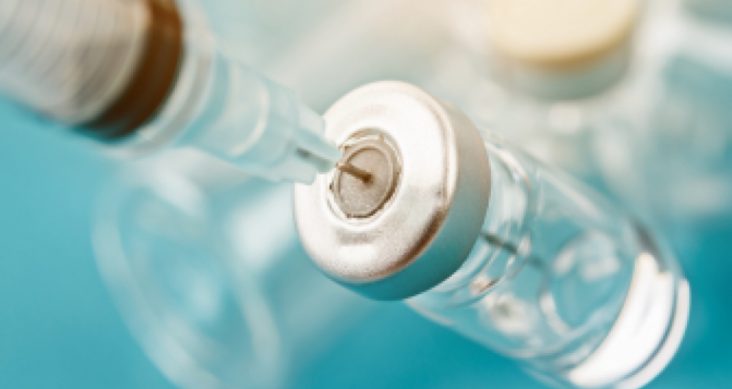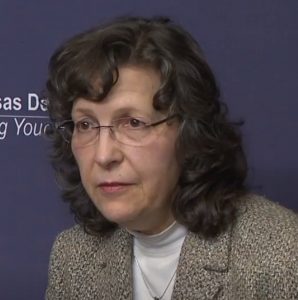Arkansas epidemiologist discusses early plans for vaccine distribution
by December 1, 2020 6:25 pm 3,601 views

At-risk health professionals in Arkansas will be first in line to receive the COVID-19 vaccine – even if they’ve already had the virus – while members of the broad general public might not start being vaccinated until April, according to state plans still being developed.
State Epidemiologist Dr. Jennifer Dillaha said in an interview Dec. 1 that frontline medical professionals who work with COVID-19 patients will be among those who receive the first vaccinations, which are expected to arrive this month. The vaccines will be administered to those individuals even if they have already recovered from COVID-19 because they are at higher risk and can be reinfected.
“We know that people who have the disease do not likely develop lasting immunity, so there’s no reason not to vaccinate them,” she said.
The state’s COVID-19 Vaccination Plan is a work in progress that lays out the process for administering the vaccines in several phases. Phase 1-A includes at-risk health care workers, first responders and essential government leaders. Other at-risk or essential individuals are included in later phases.
Asked when vaccines will be available for the general population, Dillaha said, “I don’t think it will be before April. We’ll have to wait and see. It depends on the availability of how many doses of vaccine we get, and how often it’s shipped. … We’d like to be able to vaccinate them sooner, but I don’t want to raise false expectations.”
Dillaha said life can return to some semblance of normalcy when enough people are vaccinated to change the spread of the disease. Yet to be determined is whether the vaccines will protect only the immunized or if they also will prevent the disease from being transmitted to another person.

According to the Arkansas Democrat-Gazette, Secretary of Health Dr. Jose Romero told lawmakers Nov. 30, it would be “at least until the middle, until three quarters of next year before we have enough people fully vaccinated in order we can begin to return somewhat to normal.”
The planning is taking shape as Arkansas nears an expected allocation of its first round of vaccines. Romero told legislators Nov. 30 that the state expects to receive approximately 25,000 doses in the first batch, but Dillaha said Dec. 1 that is “a number we had been given to plan with, but it’s not official.” Gov. Asa Hutchinson said the number was previously higher.
The 25,000 doses would be the first dose of a two-dose regimen, with the second dose to be shipped later. The first batch would be produced by Pfizer, whose vaccine will be considered for approval by the Food and Drug Administration Dec. 10. Supplies of the drug are being prepositioned for distribution, though none are yet in Arkansas, Dillaha said. Hutchinson said they could be here within 24 hours after approval.
The FDA will meet to consider approval of a vaccine produced by Moderna on Dec. 17. Once it’s approved, it could be available in Arkansas shortly afterward. Dillaha said she didn’t know how often the state will receive shipments after the first round, but it could be weekly.
Asked when he would be vaccinated in his weekly press conference Dec. 1, Gov. Hutchinson said, “It is very important that the public understand that I have confidence in the vaccine and the FDA approval process, and whenever it’s my turn and allocation, then I would certainly be willing and interested in taking the vaccine. In terms of priorities, the priority would be health care workers, the priority would be those in the nursing homes, and I certainly want those to be taken care of first.”
Phase 1-B includes essential workers who are at increased risk of infection including school and daycare employees, meatpacking plant workers, government employees and others. It also includes executive and legislative branch employees and elected officials.
Dillaha said Phase 1-C could include individuals age 65 and above and those with chronic conditions. This is a new phase that has been added since the plan’s most recent draft, which listed those individuals in Phase 1-B. Dillaha said there won’t be enough doses available to include that population in an earlier phase.
Phase 1 vaccinations would occur using a closed point of distribution method that would not be open to the public, according to the plan. In Phase 2, other members of those Phase 1 groups would be vaccinated, as would be additional health care employees in clinics, dentists’ offices and pharmacies. Other individuals would include utility, transportation, grocery store, food processing and manufacturing employees, university employees, and residents of long-term care and other congregate-living facilities.
Phase 3 would occur when the vaccine supply is sufficient and demand is slowing for vaccinations.
The various phases are still being determined and are being based on recommendations being made by the Advisory Committee on Immunization Practices, a national group chaired by Romero that is advising the U.S. Centers for Disease Control and Prevention. It was scheduled to vote on recommendations Dec. 1.
A state-based Vaccine Medical Advisory Committee will recommend to Romero how to apply the CDC’s recommendations.
Dillaha, who lives with her brother, said she hasn’t seen her oldest son for more than a year and didn’t attend his wedding, while her younger sons who previously lived full-time with her have been in Idaho since August. She’s encouraging them to stay there at least until spring. Thanksgiving was held via Zoom across three states. Dillaha said she is concerned about the holiday season, which will “put people in a position of having to make some difficult decisions.” She is encouraging people to celebrate Christmas with members of their household.
“I think people may underestimate (the virus), and I’m concerned that will lead them to make a decision to see their families, which they will regret later,” she said.
